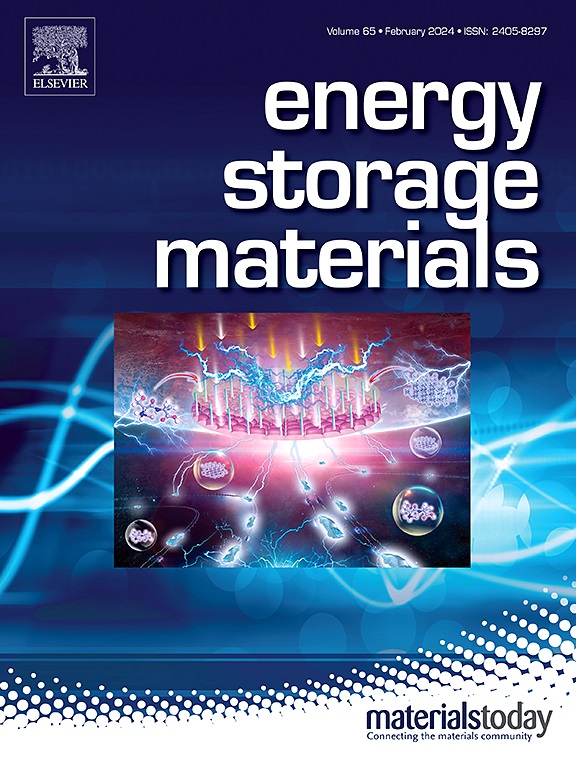NASICON-Type NaV2(PO4)3 as High-Voltage and Stable Cathode Materials for Manganese Metal Batteries
IF 18.9
1区 材料科学
Q1 CHEMISTRY, PHYSICAL
引用次数: 0
Abstract
Manganese-based batteries (MBs) have emerged as a compelling class of aqueous energy storage systems, owing to their intrinsic safety, low cost, and high energy density. In this study, we report a high-voltage aqueous MB employing NASICON-type NaV₂(PO₄)₃ (NVP) as a structurally robust cathode and metallic manganese as the anode. The cell delivers a discharge capacity of 41.1 mAh g⁻¹ at 0.4 A g⁻¹ and retains 79.4% of its initial capacity after 1000 cycles, underscoring excellent long-term cycling stability. Combined spectroscopic and structural characterizations reveal that Na⁺ ions are extracted from the NVP framework during charging, while Mn²⁺ ions from the electrolyte are reversibly inserted into the vacant interstitial sites upon discharge. The cation diffusion analyses further confirm the viability of Mn²⁺ transport within the NASICON lattice. Compared to conventional Zn-based aqueous batteries, the Mn-based system achieves a higher operating voltage (∼0.34 V), attributed to the lower redox potential of Mn. Although challenges such as Mn dissolution and interfacial resistance remain, this work establishes NVP-based MBs as a promising platform for next-generation aqueous rechargeable batteries with improved voltage output and cycling stability.

作为锰金属电池高压稳定正极材料的nasicon型NaV2(PO4)3
锰基电池(mb)由于其固有的安全性、低成本和高能量密度,已经成为一种引人注目的水性储能系统。在这项研究中,我们报道了一种采用nasiconon型NaV₂(PO₄)₃(NVP)作为结构坚固的阴极和金属锰作为阳极的高压水性MB。该电池在0.4 a g⁻¹时的放电容量为41.1 mAh,在1000次循环后仍能保持其初始容量的79.4%,具有良好的长期循环稳定性。结合光谱和结构表征表明,在充电过程中,Na +离子从NVP框架中被提取出来,而在放电过程中,电解质中的Mn +离子可逆地插入到空位上。阳离子扩散分析进一步证实了Mn 2 +在NASICON晶格内传输的可行性。与传统的锌基水溶液电池相比,由于锰的氧化还原电位较低,锰基系统可以实现更高的工作电压(~ 0.34 V)。尽管锰溶解和界面阻力等挑战仍然存在,但这项工作使基于nvp的MBs成为下一代水性可充电电池的有前途的平台,具有更好的电压输出和循环稳定性。
本文章由计算机程序翻译,如有差异,请以英文原文为准。
求助全文
约1分钟内获得全文
求助全文
来源期刊

Energy Storage Materials
Materials Science-General Materials Science
CiteScore
33.00
自引率
5.90%
发文量
652
审稿时长
27 days
期刊介绍:
Energy Storage Materials is a global interdisciplinary journal dedicated to sharing scientific and technological advancements in materials and devices for advanced energy storage and related energy conversion, such as in metal-O2 batteries. The journal features comprehensive research articles, including full papers and short communications, as well as authoritative feature articles and reviews by leading experts in the field.
Energy Storage Materials covers a wide range of topics, including the synthesis, fabrication, structure, properties, performance, and technological applications of energy storage materials. Additionally, the journal explores strategies, policies, and developments in the field of energy storage materials and devices for sustainable energy.
Published papers are selected based on their scientific and technological significance, their ability to provide valuable new knowledge, and their relevance to the international research community.
 求助内容:
求助内容: 应助结果提醒方式:
应助结果提醒方式:


